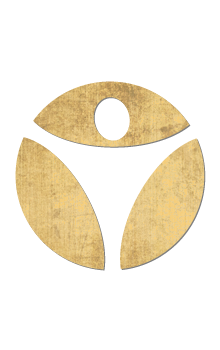Yoga for Beginners: The Complete Guide
- Updated on: January 20, 2022
Yoga is an ancient practice originating from Hindu tradition, and in its original verb form, yoga means: to engage, to practice, to connect. But, it’s a mistake to assume that yoga was invented, and never changed. In fact, the modern yoga we know today is the result of many evolutions over 5,000 years, with the physical component of yoga included as a recent concept.
In our comprehensive guide, we’ll cover everything you need to know about yoga. By the end of this guide, you’ll feel comfortable and ready to throw on your favorite yoga clothes, grab a mat, and start working on your downward dog.
In this guide, we’ll go over:
- Assessing your readiness to do yoga
- Unexpected yoga enthusiasts: including old people and inflexible people
- Get Excited: Fun yoga statistics
- How to find a yoga class near you
- Is your yoga studio beginner friendly?
- What results to expect from your yoga class
- The different types of yoga
- Different types of yoga poses
- Online beginner’s resources
- The most popular beginner’s yoga on YouTube
- Tips for yoga newbies
- Stepping into your first yoga class: what to expect
- Mistakes to avoid in your first yoga class
- Common yoga pose mistakes
Assessing Your Readiness to Do Yoga
We’re excited that you’re excited to start doing yoga. But, like any physical activity, you should first reflect on whether you:
1. Have any mobility issues?
Perhaps you sprained your knee recently, and will need to adjust for certain poses such as a triangle pose. That’s OK, because yoga teachers will provide modifications to your practices to allow for injuries.
2. Have any flexibility concerns?
If you’re jumping into an all-levels yoga class, or watching a class online, you’ll notice that you have very athletic and flexible classmates. Some of your classmates might even be able to do a headstand without any assistance. With practice and patience, you’ll also be able to master difficult yoga poses. But, flexibility doesn’t happen overnight. If you can’t touch your toes, you might need a few weeks of extra practice before you start more difficult yoga poses. That’s totally normal, and expected.
3. What is your overall fitness level?
While yoga is both a physical and mental activity, there will be poses and classes that are physically tiring. Be honest with yourself about your overall fitness level to avoid leaving a class frustrated. In some flow classes, you may be expected to continuously change poses, leading to a high level of cardiac activity. If you’re taking a yoga class at your local gym, you may also expect to see a greater focus on keeping up your heart rate.
There’s no “right” or “wrong” way to do yoga–so make sure to choose a class that fits your needs, fitness level, and flexibility/mobility restrictions. Be honest with yourself when assessing your ability to jump into a yoga class.
If you’re not honest with yourself about assessing your overall fitness levels, you may end up seriously injured. Take it slow, and build your way up rather than dangerously overextending your body.
Get excited: Fun yoga statistics
There are over 36 million people who are currently practicing yoga in the United States, so you can be assured that you’re joining not only a new activity but becoming a member of a community.
Obtain inner peace: 41% of consumers say that yoga helps them find inner peace.
And, you can get a good night’s rest: 59% of yogis say that yoga contributes to a good night’s sleep.
You can do yoga in the morning or at night, but it’s most common for yoga practitioners to put their heads to the mat between 6 AM and 10 AM. Perhaps they’re looking to peacefully start off their days.
It’s going digital: yoga, like most other aspects of our lives, is also available digitally. And, almost a quarter of yoga practitioners in the US are practicing yoga digitally. As the pandemic continues, it wouldn’t be surprising if the number of digital practitioners significantly increases.
And, once you get into yoga, you’ll keep doing it: 67% of yoga practitioners reported doing more yoga than they did in the previous year.
Unexpected Yoga Enthusiasts, Including Old People and Inflexible People
Although your idea of yoga might be rooted in media images of super-fit, young people doing yoga, that couldn’t be further from the truth.
Yoga for older people has many advantages and can be beneficial to preventing aging, fixing a rounded back, and relieving body pain. In addition, yoga can help alleviate mental stress and depression, promoting an overall healthy approach to aging. You can learn more about yoga for older people here.
Another unexpected group of people: yoga for inflexible people. Yes, it’s a myth that you need to already be flexible to do yoga. Flexibility is simply a result of doing a lot of yoga, but it’s not a pre-requisite or even the main outcome. If you’re interested in taking up yoga for inflexible people, you’ll join a community of individuals who are doing yoga for benefits such as increased energy and better overall performance. There are countless resources for yoga for inflexible people-don’t let your flexibility level stand in the way of making a life-changing decision to start yoga.
Because of the multitude of benefits such as better sleep and pain relief, it makes sense for every group to do yoga, from teachers to athletes. The beauty of yoga is that it can be tailored to fit a particular group’s needs.
How to find a yoga class near you
After you’ve assessed your readiness to get started with yoga, the next step is finding a yoga class near you. Of course, you can type in “yoga class near me,” but you might be overwhelmed by the hundreds of results. And, Google sometimes doesn’t tell you the full story–perhaps there’s a specific type of yoga you’re interested in or you’re not concerned with distance, but are more concerned with quality.
Here’s a quick checklist to finding a yoga class near you:
1) What type of yoga are you looking for?
2) Does the studio offer beginner-focused classes?
3) How large are the classes?
4) Inquire whether the instructor will demonstrate poses, which is a necessity for beginners.
5) Check Meetup to find an outdoor class to participate in.
Here are some alternative ways to find yoga classes near you:
1. Ask a friend.
A trusted friend’s recommendation can help point you in the right direction.
2. Join a local Facebook group for yogis and ask.
Yoga practitioners are friendly and can offer helpful insights that you may overlook.
3. Check out fitness apps where you may already be subscribed as a member.
Classpass and Mindbody are two fitness apps where you can sign up for individual fitness classes, many of which include yoga. This can be a good option if you’ve already purchased a subscription and want to try different types of classes. Some apps even have reviews listed for specific classes.
4. Try the Body by Yoga fitness app
Get the most physical benefits out of your yoga class by signing up for a Body by Yoga fitness app and see positive outcomes.
Is your yoga studio beginner-friendly?
When looking for classes, look out for classes that say “All-Levels,” “Beginners,” or “Introduction.” However, be aware that an all-levels class might include yoga experts, so if you’re looking to only be surrounded by beginners, choose a class that explicitly states that it’s for beginners. On the other hand, it can be helpful to see other students who are at a higher level than you, but performing the advanced versions of poses. This really depends on your personality–do you enjoy the challenge of seeing others who are more advanced or would you rather choose a class that’s specifically modified to your level?
Keep your eyes peeled for words such as: hatha, yin, gentle, or slow flow, which can be indicators that the class is beginner-friendly and will move at a pace in which you’re comfortable following.
When in doubt, get in contact with the studio and ask. Never assume that you know the level of yoga in the studio because many different yoga studios have different rankings for levels (for example, there might be: Introductory, Level 1, Level 2, and so on…or Level 1,2,3). It’s beneficial for everyone to clarify the class difficulty–your yoga instructor also wants to know whether they should adjust the class difficulty.
Some helpful questions you can ask to assess class difficulty:
-
Is this class for beginners or mixed-level?
-
Will the teacher provide modifications to make the poses easier?
- Is this class the same every week, or does it grow in difficulty? For example, some classes are part of a series, so while it may be a beginner class, you may be jumping into Class #3 of 10 of a beginner’s series, and it may be more beneficial to wait to start at Class #1. This will depend on the studio.
The more information you have, the better decision you can make based on your unique set of circumstances. Never be afraid to ask if you’re not sure what a class means, or what different levels signify.
What results to expect from your yoga class
Depending on the goals you set for yourself, you can expect different results based on how frequently you attend yoga class.
After your first yoga class, you can expect to be relaxed, perhaps a bit sore, but overall more flexible than when you first started the class. After a series of classes, you’ll see yourself able to do more difficult poses, and you’ll start to recognize the flow of the class if you’re attending classes at the same studio. You can also expect to have more tangible goals than when you first started–perhaps you want to bend deeper on triangle pose and touch your toes.
Many athletes incorporate yoga into their weekly workouts to stay flexible and toned, so you may also see changes to your flexibility and overall health levels. Of course, these changes don’t happen overnight, and the more consistently you attend a yoga class, the more likely it is that you’d see changes to your flexibility or body.
By the end of a yoga class, you can expect to know the basic poses and the names of the poses, the flow of the yoga class (how to greet the teacher at the beginning and end), and which areas of your body might need some extra care.
Lastly, when setting goals for your yoga journey, be realistic and ask yourself how many times per week are you willing to commit? How does yoga fit into your workout schedule?
The different types of yoga
When you’re looking at yoga classes, you’ll see different names of classes that indicate that type of yoga. In fact, some studios focus on solely one type of yoga, while others offer a range of different yoga classes.
We’ll cover the most popular types of yoga that you’d see on a yoga class schedule:
- Vinyasa: Vinyasa yoga is focused on the flow of movements, with different movements strung together to create a sequence of movements that flow from one to the next. A vinyasa class will likely be very active, as you’re continuing to change positions.
Try vinyasa if you want to stay active during the class, are looking to increase your heart rate, or would like to focus on aligning your breath with movements.
- Ashtanga: Ashtanga yoga is about the synchronization of breath, posture and gaze, which will create a class that has the same sequence every class. This class might be challenging for beginners because of the level of focus and dynamic movements.
Try ashtanga if you’re up for a challenge or want to have a class that has the same sequence each time. - Hatha: A great choice for beginners, hatha yoga encompasses basic yoga poses in a relaxed environment. Hatha is an overarching term, and many other types of yoga fall underneath the umbrella of hatha.
Try hatha if you’re a beginner (which you likely are, if you’re reading this article), and looking for a gentle workout to increase your flexibility. - Hot: Exactly what it sounds like, hot yoga is a type of yoga style where the heat is turned up, so you can expect to leave the class sweating. Any yoga style can be practiced in a hot yoga class, so be sure to read the description.
Try hot yoga if you’re looking to work up a sweat (make sure to stay hydrated) and want to relieve muscle tension.: - Iyengar: An iyengar yoga class will focus on alignment (getting the full body aligned, even with props, before going deeper) and timing. Poses are held for longer periods of time.
The name of the game here is precision. Try iyengar yoga if you want to get precise with your poses.
- Yin: A yin yoga class will focus on deep stretches, but focus on connective tissues and joints, which may include areas such as the hips.
Try yin yoga if you’re interested in stretching areas such as your hips or pelvis.
Different types of beginner’s yoga poses
While there are hundreds of yoga poses, we’ll get you started with a few basic ones that you’d likely come across in a beginner’s yoga class. You may hear the word “asana” used to describe yoga poses when reading or learning about yoga.
You may see these beginner’s yoga poses across class types, so it’s a good idea to get an understanding of them:
1. Mountain pose
Mountain pose is a standing pose, where the body is straight, feet are together, and big toes are touching. You can see it as the starting point for many other poses.
2. Low lunge
A low lounge can be found throughout yoga types, and has health benefits such as lengthening the spine and strengthening the quads and glutes.
You can perfect your low lunge here.
3. Pigeon pose
Pigeon pose can stretch your back and hips, but is very prone to mistakes. In the pose, one knee is bent, and the other leg straight.
You can find FAQs for pigeon pose here.
See pigeon pose for beginners, in action.
4. Downward-facing dog
Downward-facing dog is a famous yoga pose, and is a great stretch for your shoulders and hamstrings. You’ll need to be on all fours, with hands on the floor, then lift your knees up to make an inverted position. Here’s a quick tutorial.
5. Warrior 1 pose
Warrior 1 is a powerful stretch for the lower back and shoulders when done correctly, and can improve overall body strength. You’ll step one leg forward, knee bent, while putting the other leg behind you and hands above your head, looking to the sky.
Watch a tutorial on Warrior 1.
Online Yoga Beginner’s Resources
It shouldn’t be difficult to find yoga for beginner’s resources near you…or even online. In fact, some of the best resources are available online, for free. When checking out an online resource for beginner’s yoga, you’ll want to keep an eye out for reputable sources. And, of course, you won’t be able to find a series of full classes–so the yoga you’re doing might not be progressive in difficulty.
Here are some of the best online beginner’s resources:
- You can find free tutorials on Yoga for Athletes, Yoga for Back Pain, Gentle Yoga (great for beginners), and Power Yoga at Body by Yoga.
- For a full set of beginner’s yoga workout videos, check out this resource. You can get started by practicing these videos.
- Skillshare platforms such as Udemy and YouTube also offer a number of yoga tutorials for beginner’s resources, although some may be behind a paywall.
The most popular beginner’s yoga on YouTube
If you type “beginner’s yoga” into the search bar on YouTube, you’ll get millions of results. But, how do you filter through all those videos? We recommend that you take a step back and not only choose the most popular video, but the video that works best for your fitness goals.
For example, at Body By Yoga, there are free YouTube resources available, created by professional fitness trainers who are focused on the physical benefits of yoga. If you feel like you’re “too” inflexible for the yoga classes you see on Youtube–or you want to focus on the fitness benefits, Body By Yoga classes can help you achieve your goals.
In the YouTube series, you’ll see a number of different classes available, which can create targeted routines for your changing needs, such as yoga for back pain or yoga for running.
Tips for yoga newbies
Getting started with a new activity is never easy, and we often wish we had a mentor to give us tips before embarking on a new journey. While we can’t fit every piece of advice into one article, here are the most important yoga tips for beginners:
1) Perfection is in your head. Don’t be afraid of making a mistake, or being “too” inflexible to try yoga.
2) You might not be great at yoga when you first start–don’t let that discourage you. There are world-class athletes who are not professional or “good” at yoga by any means, but still found a way to use yoga to benefit themselves physically and mentally.
3) The breath is the key to success. When you focus on your breath, you’ll be able to align your body and mind to focus on the stretches, and go even deeper. We have a tendency to hold our breath in stressful situations–and yoga teaches you to do the opposite, and breathe deeper into a stretch.
And most importantly, don’t forget to have fun and not stress about your progress. Those advanced poses will come eventually, and even if they don’t, you’ll still gain important health benefits.
You can find a full list of tips here.
Stepping into your first yoga class: what to expect
Your first yoga class can be intimidating. There might be “more advanced” students in the front, showing off their skills–or you might be intimidated by the flow of the class. Here are some expectations for your first yoga class:
- You’ll need a yoga mat. Some studios have yoga mats available for rental. You can call ahead to double-check the policy.
- Most classes require you to leave your bag and phone away from your yoga mat, to not interrupt the class. Depending on the studio, there could be lockers available.
- You won’t wear any shoes.
- The teacher will be at the front of the room, and may come around during the class to offer any adjustments. You can tell the teacher if it’s your first yoga class, and if you have any injuries, so the yoga teacher can provide modifications.
Yoga teachers and studios have different class philosophies and rules, so the same pre-class ritual may not be the same depending on the studio.
Mistakes to avoid in your first yoga class
The same rules for a workout class also apply for yoga:
- Don’t go to class on a full stomach, as you’ll be stretching and moving your body a lot
- Don’t hold your breath during class–rather, breath into your pose
- Don’t try poses that are too difficult or painful for your body. Pain is NOT a good sign in yoga, and you should be aware of your body.
- Don’t be afraid to ask questions to clarify. Your teacher knows that you’re a beginner, and you shouldn’t feel embarrassed to get clarification.
Common yoga pose mistakes
As a yoga beginner, it’s tempting to attempt the most difficult pose, and end up bending your back or scrunching your body uncomfortably in order to achieve a deeper stretch. We strongly believe that it’s more important to gently ease yourself into the pose, keeping muscles aligned, rather than giving yourself an unnecessary injury.
Other common mistakes include:
- Not engaging the core (particularly during pigeon pose)
- Putting too much weight on one leg or side of the body (pigeon pose)
- Rounding your back during the pose (low lunge)
- Stretching your neck up (low lunge)
- Misaligning your body during poses due to inflexibility
You can find more in-depth descriptions of the above points here.
Most importantly, it’s natural to make mistakes as you learn a new skill. By maintaining awareness of common mistakes, and understanding that you don’t need to push yourself to the point of pain, you can avoid unnecessary injuries.
Yoga is a great way to improve your physical and mental health. Remember, there’s no “right” or “wrong” way to do yoga–and there’s no such thing as being too inflexible for yoga.
Recent Posts
Categories
Related Articles
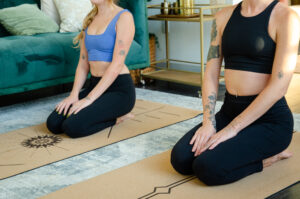
Breathing technique to improve your yoga practice
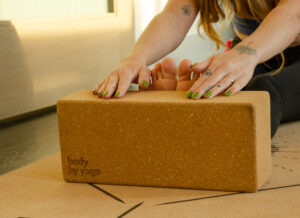
Benefits of yoga before bed
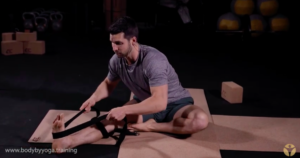
Good Stretch For Lower Back And Hamstrings
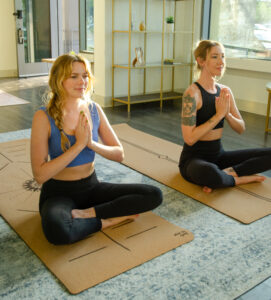
Hatha vs Power yoga
Related Articles
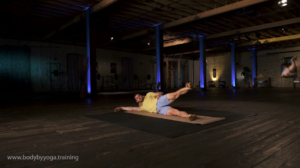
Stretching and Strengthening your hips
In this workout we start slow to warm up your hips. Utilizing low impact workouts like this can be important for beginners and yoga veterans

Hatha vs Power yoga
We’ve created our own unique style of slow burn power yoga that combines Hatha yoga, power yoga, bodyweight exercises and physical therapy. This way in

The importance of maintaining correct alignment
Everything in your body is connected, so when one muscle isnt aligned properly it can be a slippery slope to injury. Building a solid foundation
